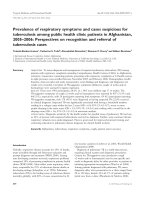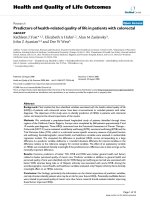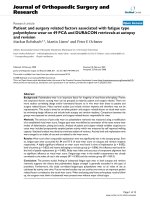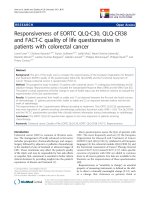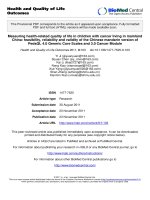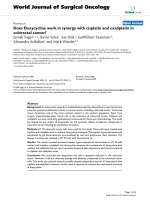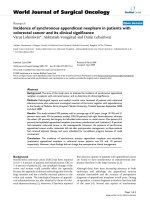Factors related with colorectal and stomach cancer screening practice among diseasefree lung cancer survivors in Korea
Bạn đang xem bản rút gọn của tài liệu. Xem và tải ngay bản đầy đủ của tài liệu tại đây (421.39 KB, 7 trang )
Park et al. BMC Cancer (2017) 17:600
DOI 10.1186/s12885-017-3583-z
RESEARCH ARTICLE
Open Access
Factors related with colorectal and stomach
cancer screening practice among diseasefree lung cancer survivors in Korea
Sang Min Park1,2†, Jongmog Lee3†, Young Ae Kim4, Yoon Jung Chang4, Moon Soo Kim4, Young Mog Shim5,
Jae Ill Zo5 and Young Ho Yun1,2,6*
Abstract
Background: Lung cancer survivors are more likely to develop colorectal and stomach cancer than the general
population. However, little is known about the current status of gastrointestinal cancer screening practices and
related factors among lung cancer survivors.
Methods: We enrolled 829 disease-free lung cancer survivors ≥40 years of age, who had been treated at two
hospitals from 2001 to 2006. The patients completed a questionnaire that included stomach and colorectal
cancer screening after lung cancer treatment, as well as other sociodemographic variables.
Results: Among lung cancer survivors, correlations with stomach and colorectal screening recommendations
were 22.7 and 25.8%, respectively. Of these, 40.7% reported receiving physician advice to screen for second primary
cancer (SPC). Those who were recommended for further screening for other cancers were more likely to receive
stomach cancer screening [adjusted odds ratios (aOR) = 1.63, 95% confidence interval (CI), 1.16–2.30] and colorectal
cancer screening [aOR = 1.37, 95% CI, 0.99–1.90]. Less-educated lung cancer survivors were less likely to have
stomach and colorectal cancer screenings.
Conclusions: Lack of a physician’s advice for SPC screening and lower educational status had negative impact
on the gastrointestinal cancer screening rates of lung cancer survivors.
Keywords: Colorectal cancer screening, Stomach cancer screening, Lung cancer survivor, Physician
recommendation
Background
Although advanced stage lung cancer has a poor
prognosis, [1] early stage lung cancer can be treated
with surgical resection, resulting in an improved
prognosis [2, 3]. Recently, the US Preventive Services
Task Force (USPSTF) recommended annual screening
for lung cancer, using low dose computed tomography
(CT) for individuals at a high risk for this disorder
[4]. Furthermore, the clinical practice of low dose CT
scanning as an early detection tool, as well as
* Correspondence:
†
Equal contributors
1
Department of Biomedical Science, Seoul National University College of
Medicine, 103 Daehak-ro, Jongno-gu, Seoul 110-799, Republic of Korea
2
Department of Family Medicine, Seoul National University College of
Medicine, Seoul, Republic of Korea
Full list of author information is available at the end of the article
advances in cancer treatment, could lead to an
increased number of lung cancer survivors [3, 4].
Previous studies have reported that lung cancer
patients were at an increased risk for second primary
cancers (SPCs) [5, 6]. For second primary gastrointestinal cancers, a recent study reported that early stage
lung cancer patients had approximately a 40% increased
risk of colorectal and stomach cancer than the general
population [6]. The Global Burden of Disease Study in
2017 has demonstrated that colorectal cancer and stomach cancer are ranked within global top 5 cancers, [7]
colorectal cancer screening and stomach cancer screening are introduced in several countries [8–10]. Cancer
survivors were recommended to adhere routine age- and
sex-appropriate cancer screening guideline in general
population [11–13]. Especially, as colorectal cancer is
© The Author(s). 2017 Open Access This article is distributed under the terms of the Creative Commons Attribution 4.0
International License ( which permits unrestricted use, distribution, and
reproduction in any medium, provided you give appropriate credit to the original author(s) and the source, provide a link to
the Creative Commons license, and indicate if changes were made. The Creative Commons Public Domain Dedication waiver
( applies to the data made available in this article, unless otherwise stated.
Park et al. BMC Cancer (2017) 17:600
the most common cancer, and stomach cancer remains
the second common cancer in Korea, [14] continued
surveillance program regarding gastrointestinal cancer
screening for Korean lung cancer survivors will be
needed. However, little is known about the gastrointestinal cancer screening practices in lung cancer survivors.
The aim of our survey was to determine the patterns of
screening for colorectal and stomach cancer screening
and related factors in lung cancer survivors who were
disease free in Korea. We hypothesized that not only
low social-demographic status but also lack of physicians’ advice for SPC screening or patients’ misperception about their risk of SPC would have negative
impacts on the gastrointestinal cancer screening behaviors in lung cancer survivors.
Page 2 of 7
≥50 years of age, using the above cancer screening
recommendations.
To assess the practices of stomach and colorectal
cancer screening after cancer treatment, lung cancer survivors were asked the following questions (Additional
file 1): 1) “When did you receive a gastroscopy or
double-contrast upper gastrointestinal series recently?”
with responses of “no,” “≤ 2 years ago,” “2–5 years ago,”
and “>5 years ago”; 2) “What kind of colorectal cancer
screening test did you receive?” with responses of “no,”
“fecal occult blood test (FOBT),” “double-contrast
barium enema,” “sigmoidoscopy,” and “colonoscopy”;
and 3) “If you receive a colorectal cancer screening,
when did you receive the last colorectal cancer screening
test?” with responses of “<1 year ago,” “1–5 years ago,”
“5–10 years ago,” and “>10 years ago.”
Methods
Study participants
Independent variables
We identified 2049 patients who had been treated for
lung cancer in two hospitals in the Republic of Korea,
between 2001 and 2006. We performed a cross-sectional
survey of lung cancer survivors in 2007. Eligible subjects
were contacted by telephone, and those who agreed to
participate were surveyed with questionnaires at home
or at the clinic. Lung cancer survivors who were treated
with curative surgery and had no other history of cancer
were eligible to participate. The institutional review
board of the National Cancer Center, Korea reviewed
and approved the protocol of our study. Details of the
study design have been previously described [15].
Lung cancer survivors were asked to approximate their
risk of SPC compared with cancer risk in general population, with the responses being lower, similar, or higher.
The survey also included question about receiving a
physicians’ recommendation to screen for SPC after lung
cancer treatment. In addition, participants were asked to
answer questions about age, highest educational attainment, ethnicity, income, health behavior (physical activity, smoking, alcohol consumption, height and weight),
and health-related quality of life (the European
Organization for Research and Treatment of Cancer
Quality of Life Questionnaire Core-30 item and lung
cancer module, Hospital Anxiety and Depression Scale
and Posttraumatic Growth Inventory) through our
systematically organized questionnaire. From the
hospital cancer registries, we gathered information about
clinical characteristics such as ages at cancer diagnosis,
tumor stage, type of surgery, history of chemotherapy or
radiotherapy, and recurrence.
Definition of appropriate uptake of gastrointestinal
cancer screening
For stomach cancer screening, Korean National Cancer
Screening Program (KNCSP) [8] recommended gastroscopy or double-contrast upper gastrointestinal series
every 2 years for general population ≥ 40 years of age,
and the Japanese government introduced gastroscopy as
a national screening program [9, 16]. For early detection
of colorectal cancer, annual FOBT was recommended
for those ≥50 years of age by the KNCSP [8] and by the
USPSTF. The American Cancer Society (ACS) has
recommended sigmoidoscopy every 5 years, a doublecontrast barium enema every 5 years, or a colonoscopy
every 10 years [10, 17, 18]. However, colorectal screening
guidelines for the general population could underestimate the actual needs of cancer survivors. One previous
study reported that for cancer survivors aged 40-yearsold, colonoscopy every 5 years might be an economically
feasible strategy [19]. As a baseline analysis of colorectal
cancer screening, we considered all the above mentioned
recommendations to be compliant with colorectal
screening among lung cancer survivors ≥40 years of age.
We also performed sensitivity analysis with subject
Statistical analysis
Descriptive statistics were reported for each response.
Among subjects, those who received gastroscopy or
double-contrast upper gastrointestinal series within
2 years were defined as lung cancer survivors with appropriate stomach cancer screening [8]. Lung cancer
survivors who received FOBT within 1 year, a doublecontrast barium enema within 5 years, sigmoidoscopy
within 5 years, or colonoscopy within 10 years were
defined as receiving appropriate colorectal cancer
screening [10, 17, 18]. We then calculated the occurrences of lung cancer survivors who had second gastrointestinal cancer screening according to these guidelines.
Adjusted odds ratios were determined by logistic
regression analysis, main independent variable being
physicians’ advice for SPC screening, perception of
Park et al. BMC Cancer (2017) 17:600
second cancer risk, highest educational attainment, and
family income adjusted for age, stage, marital status,
smoking status, and alcohol consumption. We also performed sensitivity analysis with lung cancer survivors
≥50 years of age. All statistical analyses were two-sided
and performed using STATA 10.0 software (Stata Corp.,
College Station, TX, USA). The significance level was set
at P < 0.05.
Results
Among the potentially eligible population, 126 (6.1%) had
died, 290 (14.2%) could not be contacted in spite of multiple attempts. Excluded from this study were patients
whose cancer had recurred at the time of the survey. All
participants provided written informed consent. Of the
1633 contacted patients, 727 (35.5%) refused to participate, and 906 (44.2%) consented to participate. Among
the respondents, 76 patients had cancer which had
recurred, or were receiving cancer therapy at the time.
One subject <40 years of age was excluded. The analysis
included 829 lung cancer survivors ≥40 years of age.
The mean age of 829 lung cancer survivors was
62.9 years (40–78 years). Of these, 44.2% had no more
than a 6th grade education, and 63.1% was diagnosed as
stage I lung cancer. Among disease-free lung cancer survivors, 40.7% reported receiving physician advice to
screen for other cancers. About one out of ten reported
a perception that they had a lower risk of other cancers
than the general population, and 60.1% believed that
they had a higher risk of other cancers than general
population (Table 1). When we compared the characteristics of the participants and non-participants
among1633 contacted patients, responders were more
likely to be men and to live in metropolitan areas than
non-participants (Additional file 2: Table S1).
The proportions for receiving appropriate stomach
cancer screening and colorectal cancer screening were
22.7 and 26.1%, respectively (Fig. 1). Both male and
female lung cancer survivors showed similar trends of
SPC cancer screening.
Factors related to the uptake of stomach cancer
screening for lung cancer survivors
Lung cancer survivors who recalled being informed
about the need for SPC screening were more likely to
have stomach cancer screening in multivariate-adjusted
analysis [adjusted OR (aOR) = 1.63, 95% CI, 1.16–2.30],
and these associations were greater among male patients
(Table 2). When we assessed compliance of stomach
cancer screening practices by monthly household
income and perception of SPC risk, there were no
significant differences among the groups. Lung cancer survivors with the most education (≥ 12 years)
were more likely to have stomach cancer screening
Page 3 of 7
Table 1 Demographic and clinical characteristics of disease-free
lung cancer survivors
Characteristics
Age, years (mean)
N
%
(62.9)
40–49
58
7.0
50–64
379
45.7
≥ 65
393
47.3
Male
637
76.8
Female
193
23.2
Gender
Marital Status
Married
764
90.7
Unmarried, divorced, or bereaved
66
9.3
≤ 6 years
229
44.2
7–11 years
389
28.6
≥ 12 years
210
27.2
≥ 3000
225
27.2
1000–2999
363
43.8
< 1000
240
29.0
I
519
63.1
II
173
21.0
III
131
15.0
Yes
337
40.7
No
491
59.3
Lower than the general population
77
9.3
Same as the general population
253
30.6
Higher than the general population
496
60.1
Level of Education
Monthly household income, $(US)
Stage
Receiving physician advice to screen for SPC
Self-perception of the SPC risk
SPC second primary cancer
(aOR = 1.72, 95% CI, 1.00–2.96), especially for male
patients (aOR 1.87, 95% CI, 1.00–3.51). Multivariate
analysis of patients ≥50 years of age showed associations between the above factors with uptake of stomach cancer screening that were similar to those of
patients ≥40 years of age.
Factors related to the uptake of colorectal cancer
screening for lung cancer survivors
Participant’s reporting to receive a physicians’ advice to
screen for other cancers was positively associated with
receiving colorectal cancer screening in both ageadjusted analysis (aOR = 1.52; 95% CI, 1.09–2.12) and
multivariate analysis (aOR = 1.37, 95% CI, 0.99–1.91;
Table 3). Self-perception of SPC risk was not
Park et al. BMC Cancer (2017) 17:600
Page 4 of 7
significantly associated with colorectal screening
practices. Less-educated patients were less likely to have
colorectal cancer screening (aOR = 1.76, 95% CI,
1.05–2.96). Family income was also significantly associated with colorectal cancer screening compliance
among female lung cancer survivors. Compared with
family income less than $1000/month, female lung cancer
survivors with a higher income (≥ $3000/month) were
more likely to undergo a colorectal cancer screening
(aOR = 5.09, 95% CI, 1.28–20.14).
When we performed a sensitivity analysis with subjects
≥50 years of age, male lung cancer survivors who
received a physicians’ advice of screening for second
cancers were more likely to have a colorectal cancer
screening (aOR = 1.48, 95%CI, 1.00–2.18).
Fig. 1 Percentage of lung cancer survivors who received stomacha
and colorectalb cancer screening. aAmong lung cancer survivors,
those who received gastroscopy or double-contrast upper
gastrointestinal series within 2 years were defined as lung cancer
survivors with appropriate stomach cancer screening. bLung cancer
survivors who received FOBT within 1 year, a double-contrast barium
enema within 5 years, sigmoidoscopy within 5 years, or colonoscopy
within 10 years were defined as receiving appropriate colorectal
cancer screening
Discussion
Our study showed that colorectal and gastric cancer
screening practices among lung cancer survivors was
less than optimal. In addition, half of these patients did
not recall receiving advice from their physicians about
SPC screening. Lack of a physicians’ advice for SPC
screening and lower educational status might have negative impact on the gastrointestinal cancer screening rates
of lung cancer survivors.
Because lung cancer survivors have an increased risk
of colorectal and stomach cancer development, [5, 6]
Table 2 Factors related to the uptake of stomach cancer screeninga for lung cancer survivors
Variables
All patients (N = 829)
%
Age-adjusted
OR (95% CI)
Male patients (N = 641)
Female patients (N = 188)
Multivariate
ORb (95% CI)
%
Age-adjusted
OR (95% CI)
Multivariate
ORb (95% CI)
%
Age-adjusted
OR (95% CI)
Multivariate ORb
(95% CI)
Receiving physician advice to screen for SPC
No
19.8
1.0
1.0
19.5
1.0
1.0
20.8
1.0
1.0
Yes
26.7
1.52 (1.09–2.11)
1.61 (1.14–2.26)
27.4
1.59 (1.09–2.32)
1.73 (1.17–2.56)
24.7
1.32 (0.66–2.63)
1.30 (0.61–2.80)
Perceived risk of SPC in lung cancer survivors
Lower than general
population (GP)
20.8
1.0
1.0
22.9
1.0
1.0
12.5
1.0
1.0
Same or higher
than GP
22.6
1.07 (0.60–1.91)
1.16 (0.63–2.13)
22.4
0.95 (0.51–1.79)
0.97 (0.50–1.88)
23.0
1.89 (0.40–8.92)
2.34 (0.44–12.43)
Monthly household income, ($US)
< 1000
19.6
1.0
1.0
18.9
1.0
1.0
22.0
1.0
1.0
1000–2999
21.8
1.11 (0.73–1.67)
1.03 (0.66–1.59)
22.5
1.20 (0.75–1.92)
1.06 (0.64–1.73)
19.5
0.79 (0.31–1.97)
1.10 (0.33–3.05)
≥ 3000
27.4
1.44 (0.91–2.23)
1.48 (0.94–2.32)
27.2
1.50 (0.88–2.56)
1.20 (0.66–1.71)
28.1
1.24 (0.48–3.21)
1.34 (0.37–4.95)
Education
≤ 6 years
17.5
1.0
1.0
14.6
1.0
1.0
24.6
1.0
1.0
7–11 years
22.7
1.33 (0.86–2.06)
1.40 (0.88–2.22)
24.7
1.88 (1.11–3.19)
1.93 (1.11–3.35)
15.9
0.51 (0.22–1.20)
0.46 (0.17–1.24)
≥ 12 years
28.6
1.78 (1.10–2.87)
1.72 (1.00–2.96)
26.9
2.09 (1.18–3.72)
1.87 (1.00–3.51)
35.9
1.43 (0.56–3.64)
1.34 (0.40–4.48)
OR odds ratio, CI confidence interval, SPC second primary cancer
a
Subjects who received gastroscopy or double-contrast upper gastrointestinal series within 2 years were defined as lung cancer survivors with appropriate
stomach cancer screening
b
Adjusted for age, stage, marital status, education, family income status, smoking status, alcohol consumption, receiving recommendation for other cancer
screening, and the perception of secondary cancer risks
Park et al. BMC Cancer (2017) 17:600
Page 5 of 7
Table 3 Factors related to the uptake of colorectal cancer screeninga for lung cancer survivors
Variables
All patients (N = 829)
%
Age-adjusted
OR (95% CI)
Male patients (N = 641)
Multivariate
ORb (95% CI)
%
22.9 1.0
Age-adjusted
OR (95% CI)
Female patients (N = 188)
Multivariate
ORb (95% CI)
%
Age-adjusted
OR (95% CI)
1.0
25.0 1.0
Multivariate ORb
(95% CI)
Receiving physician advice to screen for SPC
No
23.3 1.0
1.0
Yes
29.0 1.52 (1.09–2.12)
1.37 (0.99–1.91) 29.2 1.38 (0.96–1.99)
1.46 (1.00–2.12) 28.2 1.30 (0.68–2.48)
1.0
1.14 (0.53–2.48)
Lower than general 21.6 1.0
population (GP)
1.0
1.0
1.0
Same or higher
than GP
1.14 (0.65–2.03) 25.7 1.16 (0.62–2.16)
1.13 (0.59–2.15) 26.6 1.08 (0.32–3.62)
1.37 (0.33–5.63)
1.0
1.0
Perceived risk of SPC in lung cancer survivors
25.9 1.07 (0.60–1.91)
22.0 1.0
20.0 1.0
Monthly household income, $(US)
< 1000
24.2 1.0
1.0
24.6 1.0
22.5 1.0
1000–2999
21.6 1.96 (0.73–1.67)
0.73 (0.48–1.12) 22.5 0.85 (0.55–1.32)
0.68 (0.43–1.10) 17.9 0.88 (0.44–4.48)
1.51 (0.47–4.88)
≥ 3000
34.5 1.45 (0.91–2.30)
1.22 (0.74–2.02) 32.2 1.47 (0.89–2.41)
1.02 (0.58–1.82) 40.7 2.98 (1.18–7.53)
5.09 (1.28–20.14)
≤ 6 years
20.8 1.0
1.0
1.0
1.0
7–11 years
25.3 1.33 (0.86–2.05)
1.34 (0.87–2.09) 27.4 1.73 (1.05–2.84)
1.91 (1.13–3.23) 17.7 0.56 (0.25–1.27)
0.34 (0.12–0.94)
≥ 12 years
33.2 1.78 (1.11–2.88)
1.76 (1.05–2.96) 30.3 2.14 (1.25–3.68)
1.87 (1.02–3.41) 48.3 2.75 (1.12–6.78)
1.35 (0.40–4.48)
Education
17.8 1.0
28.6 1.0
OR odds ratio, CI confidence interval, SPC second primary cancer
a
Subjects who received FOBT within 1 year, a double-contrast barium enema within 5 years, sigmoidoscopy within 5 years, or colonoscopy within 10 years were
defined as receiving appropriate colorectal cancer screening
b
Adjusted for age, stage, marital status, education, family income status, smoking status, alcohol consumption, receiving recommendation for other cancer
screening, and perception of secondary cancer risks
following the recommendations of gastrointestinal cancer screening for the average risk population should be
needed at a minimum. However, our study showed that
less than 30% of disease-free lung cancer survivors
adhered to these colorectal and stomach screening
recommendations. Several previous studies [20, 21] and
one recent meta-analysis [22] reported that many cancer
survivors did not receive screening tests recommended
for the detection of SPCs, although cancer survivors
received more frequent screening for cancers than noncancer controls. These findings emphasized the need to
identify effective methods to increase cancer screening
practices for cancer survivors. Several interventions,
such as reminders, small media, and face-to-face education have been reported to increase screening rates in
general population [23]. However, little is known about
whether these interventions of increasing appropriate
knowledge could lead to increased SPC screening among
cancer survivors. Furthermore, an interventional trial
using educational materials to increase knowledge about
SPC screening reported no increase in actual cancer
screening for cancer survivors [24].
The present study showed that a lack of recommendation for SPC screening from physicians might have a
negative impact on the colorectal and stomach cancer
screening behaviors among lung cancer survivors.
Similarly, a previous study reported that cervical cancer
survivors who received, to whom their health care providers had recommended other cancer screening, were
more likely to receive breast cancer screening [25]. After
experiencing cancer, survivors usually have high levels of
trust in their physicians, [26, 27] and physicians’ advice
for screening might provide good opportunities to
improve SPC screening behaviors.
Only 40.7% of disease-free lung cancer survivors, however, recalled being informed about the need for SPC
screening or referred for such tests. Together with the
results of previous studies, our results suggests that
more information and training regarding appropriate
cancer screening guidelines for cancer survivors will be
needed for health care providers. Because there were few
guidelines regarding such specific SPC screening, a
feasible step should be started with increasing cancer
survivors’ compliance to cancer screening guidelines for
the general population. If physicians’ recommendation
for SPC screening would be incorporated in the
survivorship care plan, it might foster physician communication and shared care in monitoring SPC screening
for cancer survivors.
We also found educational disparities in stomach and
colorectal cancer screening among lung cancer survivors, and found income disparities in colorectal cancer
Park et al. BMC Cancer (2017) 17:600
screening among female subjects. Although several studies have reported educational and income disparities in
cancer screening practices among the general population, [28, 29] little is known about these disparities
among cancer survivors. In order to provide equal access
to SPC screening services for cancer survivors, further
collaborative efforts by policy makers, third party payers,
and healthcare providers are needed. Several previous
studied have suggested that educational disparity on
receipt of cancer screening might be mediated by the
role of health literacy [30, 31]. Further study for loweducated cancer patients will be needed to increase
appropriate knowledge and attitude for SPC screening
during or after the cancer treatment periods. Furthermore, because cancer survivors are more financially
vulnerable, [32, 33] decreasing economic barrier for SPC
screening should be considered.
Our study had several limitations. First, we used selfreported survey to assess the cancer screening compliance and physicians’ advice for SPC screening, which
were not confirmed by medical record reviews or claims.
Second, the response rate was only 44.2%. As participants could have been more likely to have preventive
health behaviors than non-participants, our estimates of
SPC screening practices among lung cancer survivors
might therefore have been overestimated. Third, our
study population consisted of Korean lung cancer
survivors and stomach cancer screening is not recommended in western countries, which may limit the
generalizability of our results. Although recent study has
demonstrated that those who received an upper endoscopy were less likely to die from stomach cancer within
the Korean national cancer screening program, [34] and
cancer survivors were usually recommended to receive
routine cancer screening guideline which is recommended in general population, [11–13] further evidences
will be needed among other ethnicities.
Conclusion
The present study showed that only a quarter of lung
cancer survivors included were meeting existing guidelines for second primary cancer screening, particularly
gastric and colorectal cancer. Physician must more
proactive in communicating the need for screening and
referring patients for such screening tests. In addition,
further public policy will be needed to decrease
educational disparities in SPC screening practices.
Additional files
Additional file 1: Questionnaires about uptake of gastrointestinal cancer
screening among lung cancer survivors. (DOCX 14 kb)
Additional file 2: Table S1. Characteristics of the participants and
non-participants. (DOC 27 kb)
Page 6 of 7
Abbreviations
aOR: Adjusted odds ratios; CI: Confidence interval; SPC: Second primary cancer
Acknowledgements
N/A.
Funding
This work was supported by the National Cancer Center Grant 0710410 and
grants from the National R&D Program for Cancer Control, Ministry of Health
& Welfare, Republic of Korea (1320330).
The design of the study and collection, analysis, and interpretation of data
and in writing the manuscript are independent from the funding sources.
Availability of data and materials
The dataset supporting the conclusions of this article is available at request
from the corresponding author.
Authors’ contributions
SMP, JL and YHY made substantial contribution to analysis and interpretation
of data, drafting and submission of the manuscript. JL, MSK, MYS, JAZ
contributed to design of the study, acquisition of the data and drafting of
the manuscript. SMP and YAK contributed to the design of the study and
performed the statistical analysis. YHY conceived the study, participated in its
design and coordination and contributed to interpretation of the data and
drafting of the manuscript. YAK and YJC participated in the design of the
study, contributed to the interpretation of the data. All authors read and
approved the final manuscript.
Ethics approval and consent to participate
The institutional review board of the National Cancer Center, Korea reviewed
and approved the protocol of our study. All participants provided written
informed consent.
Consent for publication
Not applicable.
Competing interests
The authors declare that they have no competing interests.
Publisher’s Note
Springer Nature remains neutral with regard to jurisdictional claims in
published maps and institutional affiliations.
Author details
1
Department of Biomedical Science, Seoul National University College of
Medicine, 103 Daehak-ro, Jongno-gu, Seoul 110-799, Republic of Korea.
2
Department of Family Medicine, Seoul National University College of
Medicine, Seoul, Republic of Korea. 3Center for Lung Cancer, National Cancer
Center, Goyang, Republic of Korea. 4National Cancer Control Institute,
National Cancer Center, Goyang, Republic of Korea. 5Lung and Esophageal
Cancer Center, Samsung Comprehensive Cancer Center, Samsung Medical
Center, Seoul, Republic of Korea. 6Cancer Research Institute, Seoul National
University College of Medicine, Seoul, Republic of Korea.
Received: 6 April 2016 Accepted: 22 August 2017
References
1. Visbal AL, Williams BA, Nichols FC 3rd, Marks RS, Jett JR, Aubry MC, Edell ES,
Wampfler JA, Molina JR, Yang P. Gender differences in non-small-cell lung
cancer survival: an analysis of 4,618 patients diagnosed between 1997 and
2002. Ann Thorac Surg. 2004;78(1):209–15. discussion 215
2. Sugimura H, Yang P. Long-term survivorship in lung cancer: a review. Chest.
2006;129(4):1088–97.
3. Manser R, Wright G, Hart D, Byrnes G, Campbell DA. Surgery for early stage
non-small cell lung cancer. Cochrane Database Syst Rev. 2005;1:CD004699.
4. Moyer VA, Force USPST. Screening for lung cancer: U.S. preventive services
task force recommendation statement. Ann Intern Med. 2014;160(5):330–8.
5. Chuang SC, Scelo G, Lee YC, Friis S, Pukkala E, Brewster DH, Hemminki K,
Tracey E, Weiderpass E, Tamaro S, et al. Risks of second primary cancer
Park et al. BMC Cancer (2017) 17:600
6.
7.
8.
9.
10.
11.
12.
13.
14.
15.
16.
17.
18.
19.
20.
21.
22.
23.
24.
among patients with major histological types of lung cancers in both men
and women. Br J Cancer. 2010;102(7):1190–5.
Surapaneni R, Singh P, Rajagopalan K, Hageboutros A. Stage I lung cancer
survivorship: risk of second malignancies and need for individualized care
plan. J Thorac Oncol. 2012;7(8):1252–6.
Global Burden of Disease Cancer C, Fitzmaurice C, Allen C, Barber RM,
Barregard L, Bhutta ZA, Brenner H, Dicker DJ, Chimed-Orchir O, Dandona R,
et al. Global, regional, and National Cancer Incidence, mortality, years of life
lost, years lived with disability, and disability-adjusted life-years for 32 cancer
groups, 1990 to 2015: a systematic analysis for the global burden of disease
study. JAMA Oncol. 2017;3(4):524–48.
Ministry of Health and Welfare K. National cancer screening programmes
guidelines. Seoul: Ministry of Health and Welfare; 2006.
Tashiro A, Sano M, Kinameri K, Fujita K, Takeuchi Y. Comparing mass
screening techniques for gastric cancer in Japan. World J Gastroenterol.
2006;12(30):4873–4.
Force USPST. Screening for colorectal cancer: U.S. preventive services task
force recommendation statement. Ann Intern Med. 2008;149(9):627–37.
Resnick MJ, Lacchetti C, Bergman J, Hauke RJ, Hoffman KE, Kungel TM,
Morgans AK, Penson DF. Prostate cancer survivorship care guideline:
American Society of Clinical Oncology clinical practice guideline
endorsement. J Clin Oncol. 2015;33(9):1078–85.
Nekhlyudov L, Lacchetti C, Davis NB, Garvey TQ, Goldstein DP, Nunnink JC,
Ninfea JIR, Salner AL, Salz T, Siu LL. Head and neck cancer survivorship care
guideline: American Society of Clinical Oncology clinical practice guideline
endorsement of the American Cancer Society guideline. J Clin Oncol. 2017;
35(14):1606–21.
El-Shami K, Oeffinger KC, Erb NL, Willis A, Bretsch JK, Pratt-Chapman ML,
Cannady RS, Wong SL, Rose J, Barbour AL, et al. American Cancer Society
colorectal cancer survivorship care guidelines. CA Cancer J Clin. 2015;65(6):
428–55.
Jung KW, Won YJ, Oh CM, Kong HJ, Lee DH, Lee KH. Prediction of cancer
incidence and mortality in Korea, 2017. Cancer Res Treat. 2017;49(2):306–12.
Yun YH, Kim YA, Min YH, Chang YJ, Lee J, Kim MS, Lee HS, Kim J, Choi YS,
Shim YM, et al. Health-related quality of life in disease-free survivors of
surgically treated lung cancer compared with the general population. Ann
Surg. 2012;255(5):1000–7.
Hamashima C. Benefits and harms of endoscopic screening for gastric
cancer. World J Gastroenterol. 2016;22(28):6385–92.
Smith RA, Manassaram-Baptiste D, Brooks D, Cokkinides V, Doroshenk M,
Saslow D, Wender RC, Brawley OW. Cancer screening in the United States,
2014: a review of current American Cancer Society guidelines and current
issues in cancer screening. CA Cancer J Clin. 2014;64(1):30–51.
Levin B, Lieberman DA, McFarland B, Smith RA, Brooks D, Andrews KS, Dash
C, Giardiello FM, Glick S, Levin TR, et al. Screening and surveillance for the
early detection of colorectal cancer and adenomatous polyps, 2008: a joint
guideline from the American Cancer Society, the US multi-society task force
on colorectal cancer, and the American College of Radiology. CA Cancer J
Clin. 2008;58(3):130–60.
Park SM, Kim SY, Earle CC, Jeong SY, Yun YH. What is the most costeffective strategy to screen for second primary colorectal cancers in male
cancer survivors in Korea? World J Gastroenterol. 2009;15(25):3153–60.
Earle CC, Burstein HJ, Winer EP, Weeks JC. Quality of non-breast cancer
health maintenance among elderly breast cancer survivors. J Clin Oncol.
2003;21(8):1447–51.
Nathan PC, Ness KK, Mahoney MC, Li Z, Hudson MM, Ford JS, Landier W,
Stovall M, Armstrong GT, Henderson TO, et al. Screening and surveillance
for second malignant neoplasms in adult survivors of childhood cancer: a
report from the childhood cancer survivor study. Ann Intern Med. 2010;
153(7):442–51.
Corkum M, Hayden JA, Kephart G, Urquhart R, Schlievert C, Porter G.
Screening for new primary cancers in cancer survivors compared to noncancer controls: a systematic review and meta-analysis. J Cancer Surviv.
2013;7(3):455–63.
Brouwers MC, De Vito C, Bahirathan L, Carol A, Carroll JC, Cotterchio M,
Dobbins M, Lent B, Levitt C, Lewis N, et al. What implementation
interventions increase cancer screening rates? A systematic review.
Implement Sci. 2011;6:111.
Shin DW, Cho J, Kim YW, Oh JH, Kim SW, Chung KW, Lee WY, Lee JE, Guallar
E, Lee WC. Efficacy of an educational material on second primary cancer
Page 7 of 7
25.
26.
27.
28.
29.
30.
31.
32.
33.
34.
screening practice for cancer survivors: a randomized controlled trial. PLoS
One. 2012;7(3):e33238.
Park SM, Park CT, Park SY, Bae DS, Nam JH, Cho CH, Lee JM, Earle CC, Yun
YH. Factors related to second cancer screening practice in disease-free
cervical cancer survivors. Cancer Causes Control. 2009;20(9):1697–703.
Hillen MA, Koning CC, Wilmink JW, Klinkenbijl JH, Eddes EH, Kallimanis-King
BL, de Haes JC, Smets EM. Assessing cancer patients’ trust in their
oncologist: development and validation of the Trust in Oncologist Scale
(TiOS). Support Care Cancer. 2012;20(8):1787–95.
Hillen MA, Postma RM, Verdam MG, Smets EM. Development and validation of
an abbreviated version of the Trust in Oncologist Scale-the Trust in oncologist
scale-short form (TiOS-SF). Support Care Cancer. 2017;25(3):855–61.
Ross JS, Bradley EH, Busch SH. Use of health care services by lower-income
and higher-income uninsured adults. JAMA. 2006;295(17):2027–36.
Lee K, Lim HT, Hwang SS, Chae DW, Park SM. Socio-economic disparities in
behavioural risk factors for cancer and use of cancer screening services in
Korean adults aged 30 years and older: the third Korean National Health
and nutrition examination survey, 2005 (KNHANES III). Public Health. 2010;
124(12):698–704.
Bennett IM, Chen J, Soroui JS, White S. The contribution of health literacy to
disparities in self-rated health status and preventive health behaviors in
older adults. Ann Fam Med. 2009;7(3):204–11.
Mantwill S, Monestel-Umana S, Schulz PJ. The relationship between health
literacy and health disparities: a systematic review. PLoS One. 2015;10(12):
e0145455.
Park JH, Park EC, Park JH, Kim SG, Lee SY. Job loss and re-employment of
cancer patients in Korean employees: a nationwide retrospective cohort
study. J Clin Oncol. 2008;26(8):1302–9.
Noeres D, Park-Simon TW, Grabow J, Sperlich S, Koch-Giesselmann H,
Jaunzeme J, Geyer S. Return to work after treatment for primary breast cancer
over a 6-year period: results from a prospective study comparing patients with
the general population. Support Care Cancer. 2013;21(7):1901–9.
Jun JK, Choi KS, Lee HY, Suh M, Park B, Song SH, Jung KW, Lee CW, Choi IJ,
Park EC, et al. Effectiveness of the Korean National Cancer Screening
Program in reducing gastric cancer mortality. Gastroenterology. 2017;152(6):
1319–1328 e1317.
Submit your next manuscript to BioMed Central
and we will help you at every step:
• We accept pre-submission inquiries
• Our selector tool helps you to find the most relevant journal
• We provide round the clock customer support
• Convenient online submission
• Thorough peer review
• Inclusion in PubMed and all major indexing services
• Maximum visibility for your research
Submit your manuscript at
www.biomedcentral.com/submit
